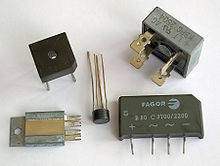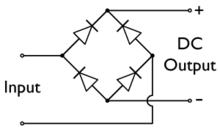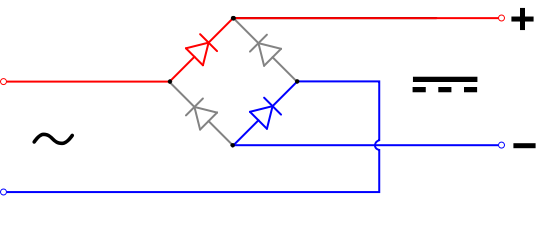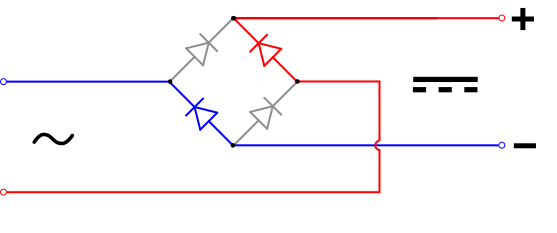| Revision as of 11:33, 31 July 2005 editHeron (talk | contribs)Administrators29,255 editsm link to bridge circuit; copyedits← Previous edit | Latest revision as of 02:47, 8 October 2024 edit undoApexParagon (talk | contribs)173 edits →Rectifier: added alt textTag: Visual edit | ||
| (497 intermediate revisions by more than 100 users not shown) | |||
| Line 1: | Line 1: | ||
| {{Alt text missing}} | |||
| A '''diode bridge''' is an arrangement of four ]s connected in a ] as shown below, that provides the same polarity of output voltage for any polarity of the input voltage. When used in its most common application, for conversion of ] (AC) input into ] (DC) output, it is known as a bridge ]. The diagram (using a popular schematic layout with the four diodes forming the sides of a diamond) describes one diode-bridge design, the full-wave ] or ] circuit. This design is used to rectify single phase AC when no transformer ] is available. | |||
| {{Short description|Circuit arrangement of four diodes}} | |||
| {{pp-pc1}} | |||
| {{Infobox electronic component | |||
| | name = Diode bridge | |||
| | image = Brueckengleichrichter IMGP5380.jpg | |||
| | caption = Diode bridge in various packages | |||
| | type = ] | |||
| | working_principle = | |||
| | invented = ] in 1895 | |||
| | first_produced = | |||
| | pins = | |||
| | symbol = ] | |||
| | symbol_caption = 2 ] (AC) inputs converted into 2 ] (DC) outputs | |||
| }} | |||
| ] side of the diode.]] | |||
| A '''diode bridge''' is a ] rectifier circuit of four ]s that is used in the process of converting ] (AC) from the input terminals to direct current (DC, i.e. fixed ]) on the output terminals. Its function is to convert the negative voltage portions of the AC waveform to positive voltage, after which a ] can be used to smooth the result into DC.<ref>{{Cite book |last1=Yazdani |first1=Amirnaser |title=Voltage-Sourced Converters in Power Systems Modeling, Control, and Applications |last2=Iravani |first2=Reza |date=15 February 2010 |publisher=Willey |isbn=9780470521564 |language=English}}</ref> | |||
| ] | |||
| ] | |||
| When used in its most common application, for conversion of an ] (AC) input into a ] (DC) output, it is known as a '''bridge rectifier'''. A bridge ] provides ] from a two-wire AC input, resulting in lower cost and weight as compared to a rectifier with a three-wire input from a ] with a ] secondary winding.<ref name=AOE>{{cite book |last1=Horowitz |first1=Paul |last2=Hill |first2=Winfield |title=The Art of Electronics |url=https://archive.org/details/artofelectronics00horo |url-access=registration |edition=Second |publisher=Cambridge University Press |year=1989 |pages= |isbn=0-521-37095-7}}</ref> | |||
| The essential feature of this circuit is that for both polarities of the ] between | |||
| the bridge inputs, the polarity of the outputs is the same. | |||
| ⚫ | Prior to the availability of ]s, a bridge rectifier was constructed from separate diodes. Since about 1950, a single four-terminal component containing the four diodes connected in a bridge configuration has been available and is now available with various ] and current ratings. | ||
| For example, when the input connected at the left corner of the diamond is positive with respect to the one connected at the right, | |||
| ] flows to the right across the upper colored path, and overall to the left across the lower one. | |||
| Diodes are also used in bridge topologies along with capacitors as ]s. | |||
| ] | |||
| == History == | |||
| When the right input is positive relative to the left, current flow is overall diagonally up to the right, and diagonally up to the left. | |||
| The diode bridge circuit was invented by ] and patented in December 1895 in Great Britain<ref>.</ref> and in January 1896 in Germany.<ref></ref><ref>{{cite journal |last1=(Editorial staff) |title=''Ein neues Gleichrichter-Verfahren'' |journal=Elektrotechnische Zeitschrift |date=24 June 1897 |volume=18 |issue=25 |page=359 and footnote |url=https://babel.hathitrust.org/cgi/pt?id=njp.32101050985074;view=1up;seq=381 |trans-title=A new method of rectification |language=de}}</ref> In 1897, ] independently invented and published a similar circuit.<ref>See: | |||
| * {{cite journal |last1=Graetz |first1=L. |title=''Electrochemisches Verfahren, um Wechselströme in Gleichströme zu verwandeln'' |journal=Sitzungsberichte der Mathematisch-Physikalischen Classe der Königlich Bayerischen Akademie der Wissenschaften zu München (Transactions of the Mathematical-Physical Classes of the Royal Bavarian Academy of Sciences in Munich) |date=1 May 1897 |volume=27 |issue=10 |pages=223–228 |doi=10.1002/andp.18972981008 |bibcode=1897AnP...298..323G|url=https://babel.hathitrust.org/cgi/pt?id=hvd.32044092897610;view=1up;seq=1069 |trans-title=Electrochemical method of changing alternating into direct currents |language=de}} | |||
| * {{cite journal |last1=Graetz |first1=L. |title=''Electrochemisches Verfahren, um Wechselströme in Gleichströme zu verwandeln'' |journal=Annalen der Physik und Chemie |date=1897 |volume=62 |pages=323–327 |url=https://babel.hathitrust.org/cgi/pt?id=wu.89048352934;view=1up;seq=385 |series=3rd series |issue=10 |doi=10.1002/andp.18972981008 |bibcode=1897AnP...298..323G |trans-title=Electrochemical method of changing alternating into direct currents|language=de}} | |||
| * {{cite journal |last1=Graetz |first1=L. |title=''Electrochemisches Verfahren, um Wechselströme in Gleichströme zu verwandeln'' |journal=Elektrotechnische Zeitschrift|date=22 July 1897 |volume=18 |issue=29 |pages=423–424 |doi=10.1002/andp.18972981008 |bibcode=1897AnP...298..323G|url=https://babel.hathitrust.org/cgi/pt?id=njp.32101050985074;view=1up;seq=445 |trans-title=Electrochemical method of changing alternating into direct currents |language=de}} | |||
| </ref><ref>{{cite book |editor-last1=Strzelecki |editor-first1=Ryszard Michal |editor-last2=Benysek |editor-first2=Grzegorz |url=https://books.google.com/books?id=LqWPPiSM5M0C&pg=PA57 |title=Power Electronics in Smart Electrical Energy Networks |isbn=9781848003187 |publisher=Springer |date=August 29, 2008 |page=57}}</ref> Today the circuit is sometimes referred to as a "Graetz circuit" or "Graetz bridge".<ref>{{cite web |url=http://www.mathworks.in/help/physmod/hydro/examples/graetz-flow-control-circuit.html |title=Graetz Flow Control Circuit |url-status=dead |archive-url=https://web.archive.org/web/20131104072407/http://www.mathworks.in/help/physmod/hydro/examples/graetz-flow-control-circuit.html |archive-date=2013-11-04 }}</ref> | |||
| == Current flow== | |||
| According to the ] of ] flow, originally established by ] and still followed by most engineers today<ref>Stutz, Michael (stutz@dsl.org), , ''All About Circuits'', Vol. 1, Chapter 1, 2000.</ref>), current flows through ]s from the positive to the negative pole (defined as positive flow). In actuality, ] in a conductor nearly always flow from the negative to the positive pole. In the vast majority of applications, however, the actual direction of current flow is irrelevant. Therefore, in the discussion below the conventional model is retained. | |||
| The fundamental characteristic of a diode is that current can flow only one way through it, which is defined as the forward direction. A diode bridge uses diodes as series components to allow current to pass in the forward direction during the positive part of the AC cycle and as shunt components to redirect current flowing in the reverse direction during the negative part of the AC cycle to the opposite rails. | |||
| ] | |||
| == Rectifier == | |||
| ] | |||
| In the diagrams below, when the input connected to the left corner of the diamond is positive, and the input connected to the right corner is negative, current flows from the upper supply terminal to the right along the red (positive) path to the output and returns to the lower supply terminal through the blue (negative) path. | |||
| In each of those cases, the top right output remains positive with respect to the lower right one. Since this is true whether the input is AC or DC, this circuit not only produces DC power when supplied with AC power: it also can provide what is sometimes called "reverse polarity protection". That is, it permits normal functioning when ] are installed backwards or DC input-power supply wiring "has its wires crossed" (and protects the circuitry it powers against damage that might occur without this circuit in place). | |||
| ] | |||
| ⚫ | Prior to availability of integrated |
||
| When the input connected to the left corner is negative, and the input connected to the right corner is positive, current flows from the lower supply terminal to the right along the red (positive) path to the output and returns to the upper supply terminal through the blue (negative) path.<ref name=SZY>{{cite book |editor-last1=Sears |editor-first1=Francis W. |editor-last2=Zemansky |editor-first2=Mark W. |editor-last3=Young |editor-first3=Hugh D. |title=University Physics |edition=6th |publisher=Addison-Wesely Publishing Co., Inc. |date=1982 |page=685 |isbn=0201071959}}</ref> | |||
| For many applications, especially with single phase AC where the full-wave bridge serves to convert an AC input into a DC output, the addition | |||
| of a ] may be important because the bridge alone supplies an output voltage of fixed polarity but pulsating magnitude (see photograph above). | |||
| ] | ] | ||
| ] | |||
| The function of this capacitor, known as a 'smoothing capacitor' is to lessen the variation in (or 'smooth') the raw output voltage waveform from the bridge. The standard explanation for this effect is that the capacitor provides a low impedance path to the AC component of the output, reducing the AC voltage across, and AC current through, the resistive load. In less technical terms, because the charge stored in the capacitor and the voltage between its terminals have a fixed ratio, any drop in the output voltage and current of the bridge tends to be cancelled by loss of charge in the capacitor. This charge flows out as additional current through the load. Thus the change of load current and voltage is reduced relative to what would occur without the capacitor. Increases of voltage correspondingly drive current ''into'' the capacitor, thus moderating the change in output voltage / current. | |||
| In each case, the upper right output remains positive,<ref>{{cite web |url=https://www.thegeekpub.com/243767/bridge-rectifier-circuit-electronics-basics/ |title=Bridge Rectifier Circuit - Electronics Basics |website=The Geek Pub |date=15 August 2019 |access-date=3 September 2019}}</ref> and lower right output negative. Since this is true whether the input is AC or DC, this circuit not only produces a DC output from an AC input, it can also provide reverse-polarity protection; that is, it permits normal functioning of DC-powered equipment when batteries have been installed backwards, or when the leads from a DC power source have been reversed, and protects the equipment from potential damage caused by reverse polarity.<ref>{{cite web |title=Reverse Polarity Protection |at=Bridge Rectifier for Reverse Polarity Protection |website=The Renewable Energy UK Website |url=http://www.reuk.co.uk/wordpress/electric-circuit/reverse-polarity-protection/ |access-date=18 December 2023 |archive-date=4 May 2023 |archive-url=https://web.archive.org/web/20230504095844/http://www.reuk.co.uk/wordpress/electric-circuit/reverse-polarity-protection/ |url-status=live }}</ref> | |||
| For three-phase AC, a full wave bridge rectifier consists of six diodes. | |||
| ] | |||
| ] | |||
| Alternatives to the diode-bridge full-wave rectifiers are the ], and ] rectifier using two diodes and two capacitors in a bridge topology. | |||
| ⚫ | ] | ||
| ] and full-wave rectified signals<ref name="CEST">"Rectifier", ''Concise Encyclopedia of Science and Technology'', Third Edition, Sybil P. Parker, ed. McGraw-Hill, Inc., 1994, p. 1589.</ref>]] | |||
| ] | |||
| ] | |||
| == Smoothing circuits == | |||
| ] | |||
| {{unreferenced section|date=October 2017}} | |||
| ] | |||
| {{See also|Rectifier#Rectifier output smoothing}} | |||
| ] | |||
| With AC input, the output of a diode bridge (called a ] for this purpose; there is also ], which does not use a diode bridge) is polarized pulsating ] voltage of the same amplitude but twice the frequency of the input. It may be considered as DC voltage upon which is superimposed a very large ]. This kind of electric power is not very usable, because ripple is dissipated as ] in DC circuit components and may cause noise or distortion during circuit operation. So nearly all rectifiers are followed by a series of ] or ]s and/or a ] to convert most or all of the ripple voltage into a smoother and possibly higher DC output. A filter may be as simple as a single sufficiently large ] or ], but most power-supply filters have multiple alternating series and shunt components. When the ripple voltage rises, ] is stored in the filter components, reducing the voltage; when the ripple voltage falls, reactive power is discharged from the filter components, raising the voltage. The final stage of rectification may consist of a ]-based voltage regulator, which almost completely eliminates any residual ripple. | |||
| ] | |||
| == Polyphase diode bridges == | |||
| {{See also|Rectifier#Three-phase rectifiers}} | |||
| The diode bridge can be generalized to rectify ] AC inputs. For example, for a three-phase AC input, a half-wave rectifier consists of three diodes, but a full-wave bridge rectifier consists of six diodes.{{Citation needed|date=April 2021}} | |||
| A half-wave rectifier may be considered a ] (star connection), because it returns the current through the center (neutral) wire. A full-wave rectifier is more like a ], although it can be connected to the three-phase source of either wye or delta and it does not use the center (neutral) wire.{{Citation needed|date=April 2021}} | |||
| ] <!-- invisible in night mode on phone browsers --> | |||
| ] | |||
| ] bridge rectifier for a ]]] | |||
| {{Clear}} | |||
| == See also == | |||
| * ] also called rectifier diodes | |||
| * ] | |||
| * ] | |||
| == References == | |||
| {{reflist}} | |||
| == External links == | |||
| {{Commons category|Bridge rectifiers}} | |||
| {{Bridge circuits}} | |||
| ⚫ | ] | ||
| ] | |||
Latest revision as of 02:47, 8 October 2024
Circuit arrangement of four diodes
 Diode bridge in various packages Diode bridge in various packages | |
| Type | Semiconductor |
|---|---|
| Inventor | Karol Pollak in 1895 |
| Electronic symbol | |
 2 alternating-current (AC) inputs converted into 2 direct-current (DC) outputs | |

A diode bridge is a bridge rectifier circuit of four diodes that is used in the process of converting alternating current (AC) from the input terminals to direct current (DC, i.e. fixed polarity) on the output terminals. Its function is to convert the negative voltage portions of the AC waveform to positive voltage, after which a low-pass filter can be used to smooth the result into DC.
When used in its most common application, for conversion of an alternating-current (AC) input into a direct-current (DC) output, it is known as a bridge rectifier. A bridge rectifier provides full-wave rectification from a two-wire AC input, resulting in lower cost and weight as compared to a rectifier with a three-wire input from a transformer with a center-tapped secondary winding.
Prior to the availability of integrated circuits, a bridge rectifier was constructed from separate diodes. Since about 1950, a single four-terminal component containing the four diodes connected in a bridge configuration has been available and is now available with various voltage and current ratings.
Diodes are also used in bridge topologies along with capacitors as voltage multipliers.
History
The diode bridge circuit was invented by Karol Pollak and patented in December 1895 in Great Britain and in January 1896 in Germany. In 1897, Leo Graetz independently invented and published a similar circuit. Today the circuit is sometimes referred to as a "Graetz circuit" or "Graetz bridge".
Current flow
According to the conventional model of current flow, originally established by Benjamin Franklin and still followed by most engineers today), current flows through electrical conductors from the positive to the negative pole (defined as positive flow). In actuality, free electrons in a conductor nearly always flow from the negative to the positive pole. In the vast majority of applications, however, the actual direction of current flow is irrelevant. Therefore, in the discussion below the conventional model is retained.
The fundamental characteristic of a diode is that current can flow only one way through it, which is defined as the forward direction. A diode bridge uses diodes as series components to allow current to pass in the forward direction during the positive part of the AC cycle and as shunt components to redirect current flowing in the reverse direction during the negative part of the AC cycle to the opposite rails.
Rectifier
In the diagrams below, when the input connected to the left corner of the diamond is positive, and the input connected to the right corner is negative, current flows from the upper supply terminal to the right along the red (positive) path to the output and returns to the lower supply terminal through the blue (negative) path.
When the input connected to the left corner is negative, and the input connected to the right corner is positive, current flows from the lower supply terminal to the right along the red (positive) path to the output and returns to the upper supply terminal through the blue (negative) path.

In each case, the upper right output remains positive, and lower right output negative. Since this is true whether the input is AC or DC, this circuit not only produces a DC output from an AC input, it can also provide reverse-polarity protection; that is, it permits normal functioning of DC-powered equipment when batteries have been installed backwards, or when the leads from a DC power source have been reversed, and protects the equipment from potential damage caused by reverse polarity.
Alternatives to the diode-bridge full-wave rectifiers are the center-tapped transformer and double-diode rectifier, and voltage doubler rectifier using two diodes and two capacitors in a bridge topology.

Smoothing circuits
| This section does not cite any sources. Please help improve this section by adding citations to reliable sources. Unsourced material may be challenged and removed. (October 2017) (Learn how and when to remove this message) |
With AC input, the output of a diode bridge (called a full-wave rectifier for this purpose; there is also half-wave rectification, which does not use a diode bridge) is polarized pulsating non-sinusoidal voltage of the same amplitude but twice the frequency of the input. It may be considered as DC voltage upon which is superimposed a very large ripple voltage. This kind of electric power is not very usable, because ripple is dissipated as waste heat in DC circuit components and may cause noise or distortion during circuit operation. So nearly all rectifiers are followed by a series of bandpass or bandstop filters and/or a voltage regulator to convert most or all of the ripple voltage into a smoother and possibly higher DC output. A filter may be as simple as a single sufficiently large capacitor or choke, but most power-supply filters have multiple alternating series and shunt components. When the ripple voltage rises, reactive power is stored in the filter components, reducing the voltage; when the ripple voltage falls, reactive power is discharged from the filter components, raising the voltage. The final stage of rectification may consist of a zener diode-based voltage regulator, which almost completely eliminates any residual ripple.
Polyphase diode bridges
See also: Rectifier § Three-phase rectifiersThe diode bridge can be generalized to rectify polyphase AC inputs. For example, for a three-phase AC input, a half-wave rectifier consists of three diodes, but a full-wave bridge rectifier consists of six diodes.
A half-wave rectifier may be considered a wye connection (star connection), because it returns the current through the center (neutral) wire. A full-wave rectifier is more like a delta connection, although it can be connected to the three-phase source of either wye or delta and it does not use the center (neutral) wire.



See also
- 1N400x general-purpose diodes also called rectifier diodes
- Active rectification
- HVDC converter
References
- Yazdani, Amirnaser; Iravani, Reza (15 February 2010). Voltage-Sourced Converters in Power Systems Modeling, Control, and Applications. Willey. ISBN 9780470521564.
- Horowitz, Paul; Hill, Winfield (1989). The Art of Electronics (Second ed.). Cambridge University Press. pp. 44–47. ISBN 0-521-37095-7.
- British patent 24398.
- (Graetz, 1897), p. 327 footnote.
- (Editorial staff) (24 June 1897). "Ein neues Gleichrichter-Verfahren" [A new method of rectification]. Elektrotechnische Zeitschrift (in German). 18 (25): 359 and footnote.
- See:
- Graetz, L. (1 May 1897). "Electrochemisches Verfahren, um Wechselströme in Gleichströme zu verwandeln" [Electrochemical method of changing alternating into direct currents]. Sitzungsberichte der Mathematisch-Physikalischen Classe der Königlich Bayerischen Akademie der Wissenschaften zu München (Transactions of the Mathematical-Physical Classes of the Royal Bavarian Academy of Sciences in Munich) (in German). 27 (10): 223–228. Bibcode:1897AnP...298..323G. doi:10.1002/andp.18972981008.
- Graetz, L. (1897). "Electrochemisches Verfahren, um Wechselströme in Gleichströme zu verwandeln" [Electrochemical method of changing alternating into direct currents]. Annalen der Physik und Chemie. 3rd series (in German). 62 (10): 323–327. Bibcode:1897AnP...298..323G. doi:10.1002/andp.18972981008.
- Graetz, L. (22 July 1897). "Electrochemisches Verfahren, um Wechselströme in Gleichströme zu verwandeln" [Electrochemical method of changing alternating into direct currents]. Elektrotechnische Zeitschrift (in German). 18 (29): 423–424. Bibcode:1897AnP...298..323G. doi:10.1002/andp.18972981008.
- Strzelecki, Ryszard Michal; Benysek, Grzegorz, eds. (August 29, 2008). Power Electronics in Smart Electrical Energy Networks. Springer. p. 57. ISBN 9781848003187.
- "Graetz Flow Control Circuit". Archived from the original on 2013-11-04.
- Stutz, Michael (stutz@dsl.org), "Conventional versus electron flow", All About Circuits, Vol. 1, Chapter 1, 2000.
- Sears, Francis W.; Zemansky, Mark W.; Young, Hugh D., eds. (1982). University Physics (6th ed.). Addison-Wesely Publishing Co., Inc. p. 685. ISBN 0201071959.
- "Bridge Rectifier Circuit - Electronics Basics". The Geek Pub. 15 August 2019. Retrieved 3 September 2019.
- "Reverse Polarity Protection". The Renewable Energy UK Website. Bridge Rectifier for Reverse Polarity Protection. Archived from the original on 4 May 2023. Retrieved 18 December 2023.
- "Rectifier", Concise Encyclopedia of Science and Technology, Third Edition, Sybil P. Parker, ed. McGraw-Hill, Inc., 1994, p. 1589.
External links
| Bridge circuits | |
|---|---|
| Resistance | |
| Resistance–Capacitance | |
| General | |
| Inductance | |
| Other | |

